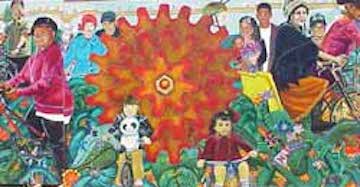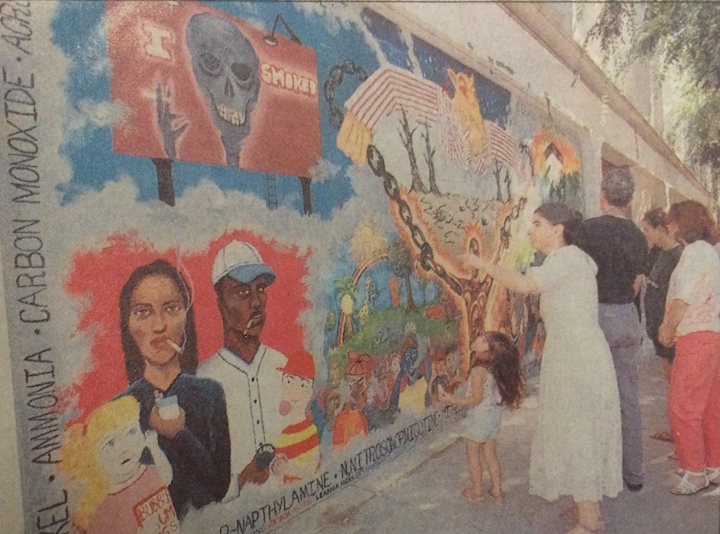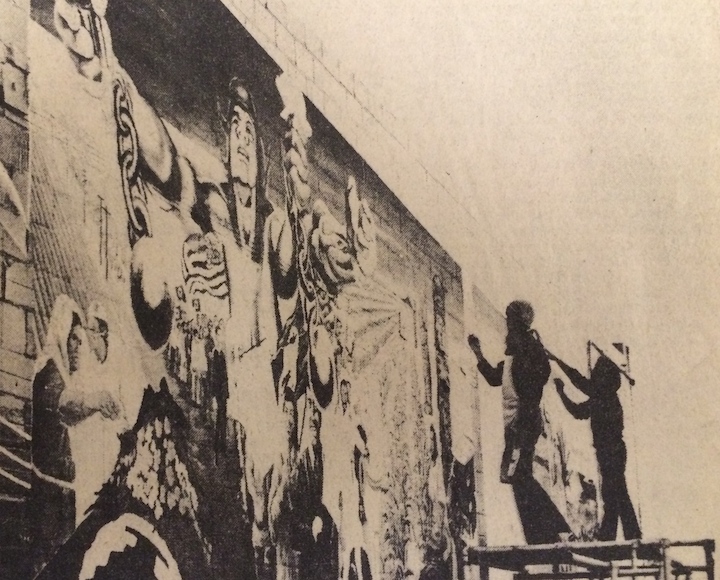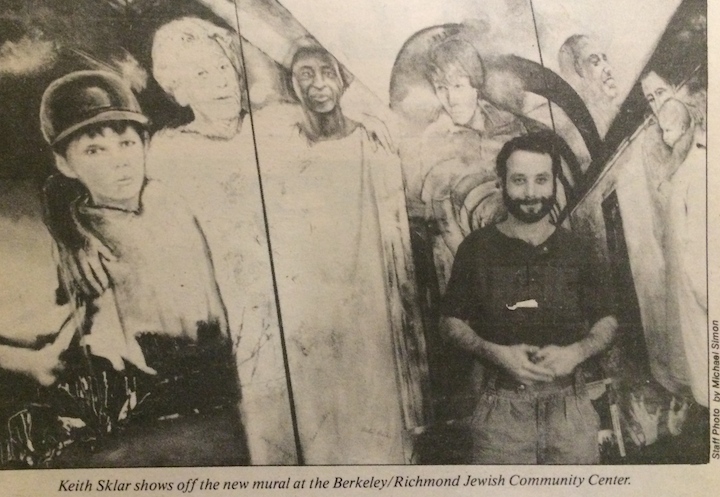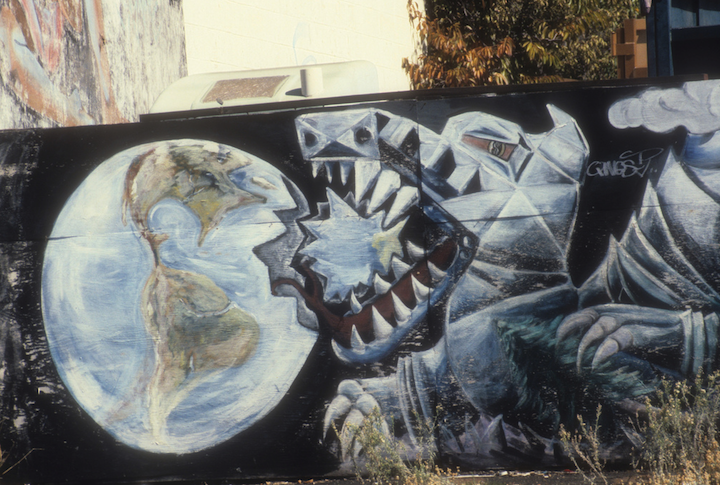From 1974 until 1977, this mural was on the long wall (25′ by 100′) at the southeast corner of Milvia and University, then a Dutchboy Paint store, now Au Coquelet. The design and execution were by Stefen. Gary Graham painted the Dutch Boy figure, a portrait of Steen. Stefen said: “I wished to assist in environmental cleanup, by creating a new urban environment Putting a large mural on a wall forces people to look twice and be aware of their surroundings. It also helps to stimulate their senses.”
Stefen painted the mural. He says: “The mural, received as a “sign” of hope and peace, and depicting the San Francisco Bay as seen from the Berkeley Hills, was up for three years when the property changed hands and a restauranteur (Au Coquelet) felt obliged to spray out the mural during the night, due to other ideas for his restaurant, and due to the city’s seismic-retrofitting requirement.”
Yes, literally painted over in the middle of the night. The owner posted a note in the window, denying that whitewashing the mural had been an act of vandalism. “It is an effort to alleviate the suffering of Mr. Stefen the artist. The destruction of his painting (or heart) is due to work required by the city of Berkeley for public safety reasons.”
Here is what Stefen had to say about the mural and murals and art and life.
The death of a mural is usually not as well chronicled as its birth, but both are chronicled with respect to the Moveable Bicycle Mural.
The Moveable Bicycle was created in 1998, painted on Addison under the leadership of Marcia Tripp. It was approximately 10 feet high and 70 feet long, commissioned by the City, celebrating bicycling in Berkeley. It was defaced, moved, defaced, and then stored at the Corporation Yard.
Where in 2003 or 2004 it got wrecked by City crews. Not on purpose or knowingly, but, still – wrecked. Art is not eternal, but – damned shame.
We all probably remember the old gymnasium at Berkeley High, torn down and replaced in the last several years.
Do you remember this mural inside?
I don’t remember it.
The gym is gone now. No chance to see the mural.
Others, all chronicled in the research files of the Berkeley Public Library:
This mural was painted over in 1990 because, the theater and property manager said, it was “ridden with graffiti.” He also said, “It wasn’t the most fabulous mural in the world, but it really represented something and was done by Berkeley High Students and done of them.” (Berkeley Voice July12, 1990).
Irene Perez painted four murals at the clinic. The Director of the Berkeley Arts Service resisted the trend by muralists to talk and work with people who had to live or work near the mural. The Director wanted “murals on demand.” This is a mural on demand.
Osha Neumann was part of a group that painted a mural on the wall of Goodwill Industries in 1976.

Mural at South Berkeley liquor store protesting crack cocaine epidemic. Daily Californian, July 14, 1989
In the fall of 1978 Osha Neumann and the Peralta College non-traditional studies mural workshop painted a 6″ by 25′ mural at the Recycilng Center Dwight and Grove (now, of course, King).
It shows a large metal monster gobbling up the earth and at the same time being dismantled and recycled by the community.
Most of these photos are, as you can see, old, faded, black and white, and from newspapers. They are not bright, sharp, vivid, and vibrant like the murals they depict. But – they are what I have and there is a certain power in these photos. The murals may not have survived the ravages of time, but the photos have.
This bright, sharp, vivid and vibrant mural is an exception to the rule:
 This is an Eduardo Pineda mural that once was found at the West Berkeley branch of the Berkeley Public Library. Pineda you know best from his glorious murals on the University Avenue Houses/Bombay Spice building and the playground on Hopkins below Martin Luther King Middle School. What a beauty this was.
This is an Eduardo Pineda mural that once was found at the West Berkeley branch of the Berkeley Public Library. Pineda you know best from his glorious murals on the University Avenue Houses/Bombay Spice building and the playground on Hopkins below Martin Luther King Middle School. What a beauty this was.
Among the gone murals of Berkeley are many from Barrington Hall, a student co-op on Dwight that was closed in 1989-1990 as a result of prolonged battles with neighbors centered around Barrington’s excesses – punk rock, anarchy, and drugs. Barrington embraced the aphorism “those who tell don’t know, and those who know don’t tell,” and so I, who doesn’t know, won’t tell much.
A Barrington bylaw protected murals. They were preserved as long as Barrington was alive, which is lovely. I have found some photos – not a lot, and not high production values. I have not found a photo of the famous Yellow Submarine mural that started it all, but here is what I have found.
I made screen shots from a 1988 home movie about Barrington. If I put all those photos here it would overwhelm the post, so I have a separate post with them. Barrington was eventually shut down. Squatters were evicted.
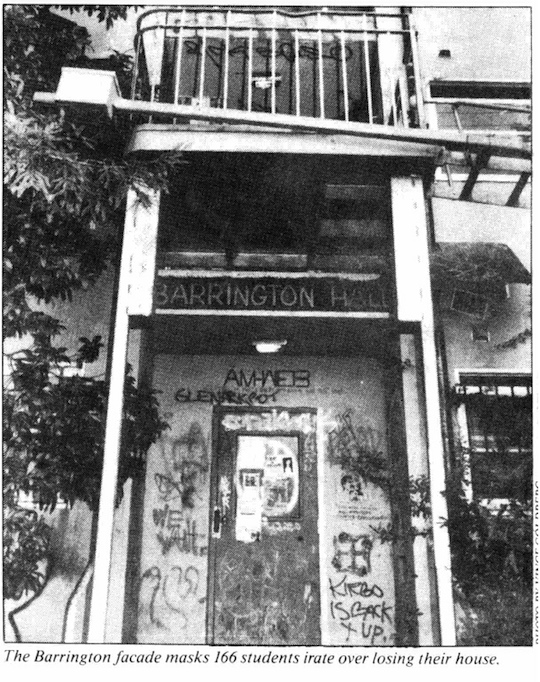 When it was shut down it was cleaned up. Murals disappeared.
When it was shut down it was cleaned up. Murals disappeared.
One more gone mural.
It was at Shattuck and Vine before its rebirth as the Gourmet Ghetto.
My friend was preoccupied when I brought him a print-out of this post in draft form. Gabby had sent him an envelope willed with magazine advertisements from the 1950s and 1960s.
 They were all variations on Maidenform’s “I dreamed I …..” advertisement. What can you say about these ads? Quirky? More than that. Kinky? Definitely. Fetish art? Absolutely.
They were all variations on Maidenform’s “I dreamed I …..” advertisement. What can you say about these ads? Quirky? More than that. Kinky? Definitely. Fetish art? Absolutely.
He looked through the photos until he got to Barrington. “Too many ghosts for me here.” He has more than once told me the story of walking by Barrington when one of the “holdovers” in the final days of Barrington fell to his death from the roof. I believe this story.
What about the murals that are gone, grainy black and white photos notwithstanding?







